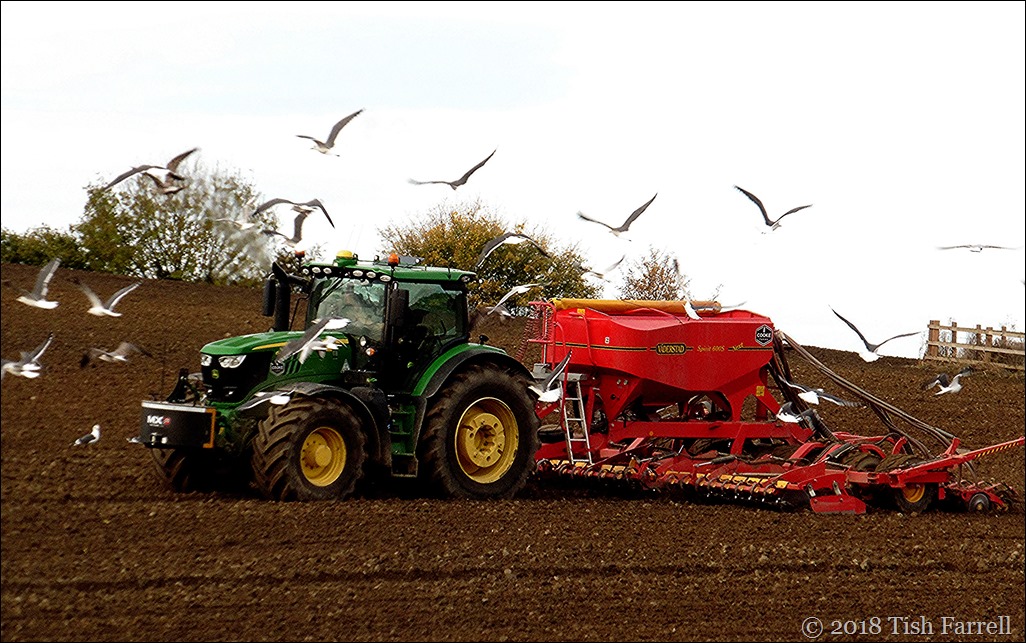Instead of rook and jackdaw call our Sheinton Street soundscape was yesterday invaded by the shriek of black backed gulls. It seemed strange when we’re so far from the nearest sea coast. But then gulls are great opportunists, and these particular ones may have learned to make their living at our nearest land-fill site rather than out at sea. The season of ploughing and sowing also provides fresh, if fleeting, feeding grounds and the gulls arrived in Townsend Meadow like a small snowstorm, though I’m guessing it wasn’t the new sown grain they were after so much as the bugs and worms turned up by the seed drill.
Once seed sowing would have done by hand, a skilled job that involved casting the grain evenly from either hand, tramping up and down the ploughed furrows. A field this size would have been a good day’s work. Now it is drilled in less than an hour.




It’s a wonder of the modern world why so many people still have to work for so many hours when machines can do the work in a short time.
That’s certainly one thought. Not sure that too much machinery is good for us in the long run.
This is a good question.
I’m still amazed at how large farm machinery is these days and how comfortable. My grandfather’s small tractor didn’t have a covered cabin area. He just sat outside in whatever the weather was. No A-C, no radio, no creature comforts, just him, the tractor and the field. My brother and I sometimes went out with him, sitting in front of him, steering while he worked the pedals. If the wind was blowing, it was dirty work, but we loved it. Of course, we didn’t have to do it every day and in all sorts of weather! Farming even today is not for sissies.
janet
I remember sitting on tractors with no cabins. And blooming hard cold metal seats too. But you’re right farmers today may have a lot of hi-tech gear, but it’s still tough in many other ways.
So much farming machinery is one of the reasons for the alarming increase in soil erosion 😕
Yes, it’s not good. We’ve had the plough, the drill, the harrow, and agrichemical input on our field in the last week – all great big machines. The soil is never allowed to rest either. Also the fairly recent fad for autumn sowing and winter wheat is said to increase soil erosion by 90%.
Yikes 😕 and I guess then lots of fertilizer. If only fallow periods were part of the cycle.
Yes, lots of fertilizer – adding to the run off in the stream…
☹
I love these pictures. Growing up in Kent I used to really enjoy the seagulls following tractors at this time of the year. Actually where I live in Hampton I hear them. Thanks Tish. 🙂
Thanks, Janet.
It would be fun to drive a tractor. 😀 😀
Ha! Now there’s an ambition, Cee 🙂
How far are you rom the sea Tish, 80 miles or so? We used to have a lot of gulls around here, but less recently. At the hospital where I work, they have to get a falcon in from time to time because they’re such a nuisance. Agriculture has changed beyond recognition in our lifetime hasn’t it? And lots of low paid jobs have gone as well.
I think we might be quite a bit more than 80 miles from the sea, Gilly. Though as the gull flies it may be shorter than I think. But yes, farming has indeed changed amazingingly. When I was a child the threshing machine that visited the farm at harvest time was straight out of Thomas Hardy – a very frightening Heath Robinson contraption.
Serious bit of kit. They are busy round here as well, and yes the gulls are after worms and bugs.
We then had two lots of quite other serious kit following the drilling. A huge harrowing device and then the mega-sprayer with retractable arms.
I love the colour combinations in these photos Tish, so very autumnal. Yes farming has changed so much from when I started farming in UK in the 1950’s. Back then I remember happy groups of us at sowing and harvesting sharing the work that is now done by one man and his big machine. Even milked by hand at one farm…
You’ve put your finger on a very important thing, Pauline. The loss of community on the farm, and the separation of the surrounding community from the farming cycle, and its casual input at key times of the year.
It was low paid work Tish, but it was a lifestyle choice and I wonder now how the communities are surviving
Looking at the first photograph, I take myself for one of the birds and enter the picture.
Looking at the 2nd photograph, I think I’m a drone.
Very beautiful pictures because they provide emotions.
Thank you for those very kind thoughts, Yoshimi.
You have more gulls in your fields than we have here! But then most of the land is pasture not arable. The gulls do come to shelter in the fields though when the weather is bad on the coast.
They seem to have imprinted on tractors at the moment. As soon one trundles onto the field, they appear from nowhere.
Beautiful captures, Tish.
I read the “Truman” and learned about the difficult life of farmers…
Thank you, Amy.